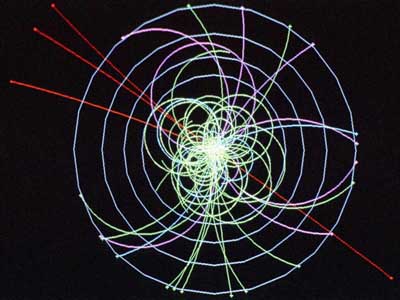Large Hadron Collider tunnel. Image courtesy of CERN
Scientists at CERN, the European Organization for Nuclear Research, have announced they are going to run the Large Hadron Collider (LHC) with a beam of energy of 4 TeV this year – that’s 0.5 TeV higher than in 2010 and 2011. CERN is aiming to determine whether the Higgs Boson exists or not this year.
CERN management made the decision following their annual performance workshop, which was held in Chamonix, France, last week. Yesterday, the external CERN Machine Advisory Committee (CMAC) also delivered a report.
CERN said its strategy is to optimise LHC running so as to deliver the “maximum possible amount” of data in 2012 before the LHC goes into a long shutdown to prepare for higher energy running.
The 2012 data target is apparently 15 inverse femtobarns for ATLAS and CMS, three times higher than in 2011. Bunch spacing in the LHC will remain at 50 nanoseconds, said CERN yesterday.
“When we started operating the LHC for physics in 2010, we chose the lowest safe beam energy consistent with the physics we wanted to do,” said CERN’s director for accelerators and technology, Steve Myers. “Two good years of operational experience with beam and many additional measurements made during 2011 give us the confidence to safely move up a notch, and thereby extend the physics reach of the experiments before we go into the LHC’s first long shutdown.”
‘Tantalising hints’ of Higgs boson
Just before Christmas, the elusive Higgs Boson had been dominating scientific news. Back on 13 December, physicists at CERN revealed they might have experienced “tantalising hints” of the Higgs boson, and that they were close to solving the riddle that has been puzzling the particle physics community and which could revolutionise the scientific field, paving the way for a new physics.
However, the physicists said at the time they could not yet make any conclusive statement on the existence or non-existence of the elusive Higgs. They did indicate that the conundrum surrounding the existence of Higgs boson would be resolved later in 2012.
Yesterday, CERN said LHC’s “excellent performance” in 2010 and 2011 has brought “tantalising hints of new physics”, narrowing the range of masses available to the Higgs particle to a window of 16 GeV.
“Within this window, both the ATLAS and CMS experiments have seen hints that a Higgs might exist in the mass range 124-126 GeV,” said the scientists.
CERN said that one more year’s worth of data is needed to turn those hints into a discovery, or to rule out the Standard Model Higgs particle altogether.

Simulated Higgs boson event: this track is an example of simulated data of a decay path of the Higgs boson that may be observed at the LHC when it started taking data in 2008. The Higgs boson is produced in the collision of two protons and quickly decays into four muons. Image credit: CERN
CERN said the LHC is on track to enter a long technical stop at the end of this year to prepare for running at its full design energy of around 7 TeV per beam.
“By the time the LHC goes into its first long stop at the end of this year, we will either know that a Higgs particle exists or have ruled out the existence of a Standard Model Higgs,” said CERN’s research director Sergio Bertolucci. “Either would be a major advance in our exploration of nature, bringing us closer to understanding how the fundamental particles acquire their mass, and marking the beginning of a new chapter in particle physics.”
CERN added that the schedule foresees beams back in the LHC next month, and running through to November. It said there will then be a long technical stop of around 20 months, with the LHC restarting close to its full design energy late in 2014 and operating for physics at the new high energy in early 2015.